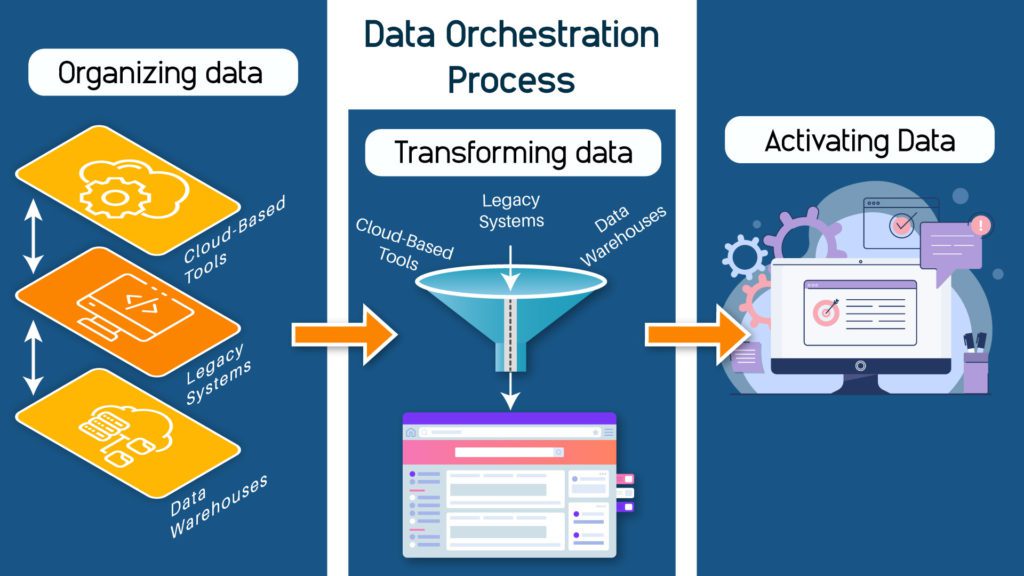The sheer volume and variety of information available to businesses can be overwhelming. Organisations are inundated with data from various sources, such as customer interactions, sales transactions, social media, and IoT devices.
However, raw data is like scattered musical notes – it takes skillful orchestration to transform it into a harmonious symphony of insights. This is where the concept of data orchestration comes into play, acting as the conductor that synchronises and directs the various elements to create a coherent and actionable composition.
Understanding Data Orchestration
Data orchestration is the meticulous process of seamlessly integrating, coordinating, and automating data flow across diverse systems and platforms. Like a conductor harmonising an orchestra, it merges data from various sources, refines it into meaningful formats, and ensures timely availability.
This empowers organisations to unleash the full potential of their data, revealing hidden insights and enhancing decision-making capabilities. Just as a symphony transforms individual notes into a coherent melody, data orchestration weaves together integration, transformation, and automation, culminating in a harmonious composition that fuels informed decisions and innovation.
The Three Pillars of Data Orchestration
Integration and Aggregation:
The first pillar of data orchestration revolves around seamlessly connecting diverse data sources. This could encompass structured data from databases, unstructured data from documents, and even real-time streaming data from sensors and IoT devices. Integrating these sources into a unified environment lays the foundation for a comprehensive view of the organisation’s operations.
By aggregating data, companies gain a 360-degree perspective, enabling them to identify patterns, trends, and correlations that might have otherwise remained hidden. For instance, an e-commerce company could integrate customer behaviour data with sales data to create personalised shopping experiences and optimise inventory management.

Data Transformation and Enrichment:
Once data is integrated, it often needs to undergo transformations to become valuable and actionable. This includes data cleaning, normalisation, and enrichment. Raw data might contain inconsistencies, errors, or missing values, which can hinder accurate analysis. Data orchestration involves cleansing and standardising data, making it ready for analysis and reporting.
Enrichment takes this a step further by enhancing data with additional context. For example, geographical data might be enriched with demographic information to enable more precise marketing targeting. Data transformation and enrichment ensure that the data being utilised is accurate, reliable, and aligned with business objectives.
Workflow Automation and Distribution:
The final pillar of data orchestration centres around automating workflows to ensure that the right data reaches the right people at the right time. Automation minimises manual intervention, reduces the risk of errors, and accelerates decision-making processes. This involves creating data pipelines that automate the movement of data through different stages, from ingestion to analysis and reporting.
Workflow automation also empowers self-service analytics, enabling business users to access and analyse data without IT assistance. This democratisation of data fosters a culture of data-driven decision-making throughout the organisation, as insights become readily available to those who need them, when they need them.

How Does Data Orchestration Differ From Automation?
While both data orchestration and automation involve streamlining data-related processes, the main difference lies in their scope and focus. Data orchestration is about orchestrating the entire data journey, from integration to transformation to distribution, with an emphasis on creating a coherent flow of data. Automation, on the other hand, is a broader concept that involves using technology to automate specific tasks or processes, which can include data-related activities but also extends to various other operational areas.
In summary, data orchestration is a specialised form of automation that focuses on orchestrating and harmonising the flow of data, while automation encompasses a wider range of tasks and processes that can be performed by machines or systems to enhance efficiency and accuracy across different business functions.
Benefits of Data Orchestration
Enhanced Data Accuracy: Data orchestration ensures that the data being used is accurate, consistent, and up-to-date. This reliability forms the basis for making informed decisions and deriving meaningful insights.
Faster Time-to-Insight: By automating data workflows and processes, data orchestration reduces the time it takes to transform raw data into actionable insights. This agility is crucial in today’s fast-paced business landscape.
Improved Collaboration: Data orchestration breaks down silos by enabling data to flow seamlessly across departments. This promotes collaboration and enables cross-functional teams to work together effectively.
Scalability: As organisations grow and their data needs expand, data orchestration provides a scalable framework that can handle increasing data volumes and complexity.
Competitive Advantage: Organisations that excel in data orchestration gain a competitive edge by leveraging data-driven insights to make proactive decisions, innovate faster, and deliver exceptional customer experiences.

Challenges and Considerations
Yet, despite its promises, data orchestration is not without challenges. Organisations embarking on this data symphony must navigate several critical considerations that can arise during the orchestration process.
First and foremost is the challenge of data security and compliance. As data flows across various platforms, ensuring its privacy and protection becomes paramount. Safeguarding against cyber threats and unauthorised access is crucial, especially considering stringent data protection regulations like GDPR or HIPAA.
Integration complexity presents another hurdle. Organisations often contend with a mix of legacy systems and modern data sources, each with unique structures. Harmonising these diverse elements into a unified orchestration framework can be intricate. Compatibility issues and data format disparities may arise, necessitating careful data mapping and transformation.
The selection of appropriate tools and technologies is vital for successful data orchestration. The tech landscape offers a plethora of options, from cloud-based solutions to on-premises frameworks. Opting for tools that align with specific needs, scalability requirements, and budgets is essential. Inadequate tools can stall the orchestration process, leading to inefficiencies.
Finally, operational shifts are also a consideration. Data orchestration often requires a cultural transformation toward a data-centric approach, where insights shape decisions. Adapting to this new mindset can face resistance, demanding effective change management strategies to foster a data-driven ethos.
How To Get Started in Data Orchestration
If you are wanting to embark on a journey of data orchestration, begin by assessing your data landscape to understand the available sources. Define your objectives clearly, setting the stage for streamlined decision-making, and select appropriate orchestration tools and technologies,before then mapping data flows and integrating diverse sources into a central repository.
Next, transform and enrich the data to ensure consistency and reliability, and automate data pipelines for seamless movement, then implement workflow automation to reduce manual intervention and enhance efficiency, while addressing security and compliance considerations.
It’s also important to continuously monitor and maintain processes, incorporating feedback and iterating for improvement. Furthermore, foster a data-driven culture through training and gradually scale your orchestrated data ecosystem to encompass more sources and processes. Through these steps, data orchestration will harmonise your data landscape, transforming it into a symphony of insights and opportunities.
Conclusion
In the symphony of modern business, data orchestration plays the role of the conductor, harmonising diverse data sources, transforming raw information into valuable insights, and automating the flow of data for timely decision-making.
As organisations continue their journey towards becoming more data-driven, mastering the art of data orchestration will be the key to unlocking the full potential of their data assets.
Just as a symphony captivates its audience with a perfectly orchestrated blend of instruments, organisations can captivate their market with a harmonious blend of data-driven insights.










